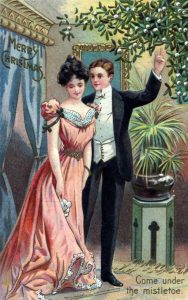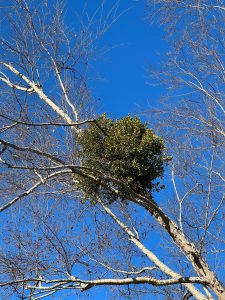
I know, I know, nobody really thinks about mistletoe unless it’s Christmas time and folks are kissing under it. But it’s winter, Valentine’s Day is coming up, and there’s still plenty of mistletoe to be seen in the leafless winter landscape.
You may have noticed it way up in the trees as you drive or walk around, and not realized what you were seeing. Mistletoe typically grows in the form of a large green sphere (sometimes several feet in diameter), tucked among the top branches of a tree. And while it is present in the landscape year-round, mistletoe’s evergreen leaves stand out in a deciduous tree that has dropped its own leaves.

So, what is mistletoe (Phorandendron serotinum), anyway? And what’s with the odd name? Well, “mistletoe” is a combination of old Anglo-Saxon terms: “mistel” for dung, and “tan” for twig. The name came from early observations that birds will poop out the seeds onto tree branches, and mistletoe plants would grow from those droppings. Mistletoe is actually a parasite—well, a hemiparasite—because it can photosynthesize and produce chlorophyll, so it’s not completely dependent on another plant. In fact, the Greek genus name Phoradendron means “thief of the tree.” I have covered several parasitic species in previous posts, and like them, mistletoe derives most of its nutritional needs from other plants. Like dodder, the “silly-string” plant that grows along the tops of shrubs, mistletoe uses primitive roots called haustoria to dig into the bark and branches of its host tree. Mistletoe absorbs water and nutrients from the tree, which can eventually kill it. There are many species of mistletoe worldwide, but in Florida it typically lives in laurel oaks. This is especially problematic, as laurel oaks are common but shorter-lived, and are vulnerable to hurricanes and tropical storms. A mistletoe infestation would only hasten its demise. Mistletoe may also be found routinely in elms, wild cherries, and sycamores, along with dozens of other species.
Because it grows high in treetops, mistletoe can be difficult to remove. A pruning pole can be used to cut it out of a tree—ideally at least 6 inches below the mistletoe’s attachment spot to make sure roots are removed. A chemical growth regulator called Ethephon can be applied during tree dormancy, but its restricted use means the applicant must have a pest control license. As a last resort, if you’ve got good aim, it can be shot out of a tree with a .22 mm rifle!

Mistletoe is an interesting plant, though, surrounded by lore from many countries and cultures. Its bright white berries are toxic and sticky, but wildly popular with a variety of birds and other wildlife. Animals as varied as elk, deer, and porcupines will eat them, and squirrels will eat the berries and use mistletoe as structural support for nests. Flycatchers, bluebirds, doves, robins, and cedar waxwings eat the berries, and cavity-nesting birds will often use the snags left behind from trees killed by mistletoe. A lovely native butterfly, the great purple hairstreak, relies on mistletoe as its sole larval food source.
Mistletoe seeds may be transported on feathers, beaks, or fur, passed through digestion, or even from the explosion of ripe berries, which may shoot seeds 50 feet! The toxicity level of the berries varies by species—the European varieties seem to be more dangerous than the American ones–but none of them are safe for human consumption.

It’s clear that mistletoe can be a bit dangerous, so why do we bring it into our homes in the depths of winter? Several ancient traditions are responsible for this. The earliest seems to be from the Celtic Druids, who believed that because it grew so high—close to heaven—it was holy and possessed the power to heal illness and predict the future. They would collect mistletoe around the winter solstice and may have used it to decorate their homes. The Greeks and Japanese associated the plant with fertility, with the Greeks beginning the tradition of kissing under it during weddings and the feast of Saturnalia (held at the end of December). The Romans and Scandinavians considered it a symbol of peace. A Nordic myth was told around mistletoe, involving a story about Loki (god of mischief) shooting the son of Frigga (the goddess of love) with an arrow or spear made from mistletoe. Frigga brought her son back to life underneath the mistletoe, declaring anyone standing below it should be kissed and protected from death. Our modern Christmas tradition that came from these legends most closely resembles the Victorian English version, in which any girl standing under mistletoe must accept a kiss or end up without any marriage proposals. This practice may have been popularized by its mention in Dickens’ “A Christmas Carol.”
Just as I have been noticing mistletoe in the trees lately, our ancestors living close to the land would have seen the signs of life in mistletoe when most every other plant was dormant. Many of these traditions stem from a widely held belief that the mistletoe was keeping these deciduous trees alive in the bleak midwinter, therefore holding sacred powers. While we now understand the scientific relationship between mistletoe and its tree host, its ancient mystical history still plays a small part in our modern traditions.
Source: UF/IFAS Pest Alert
Note: All images and contents are the property of UF/IFAS.



